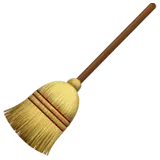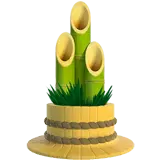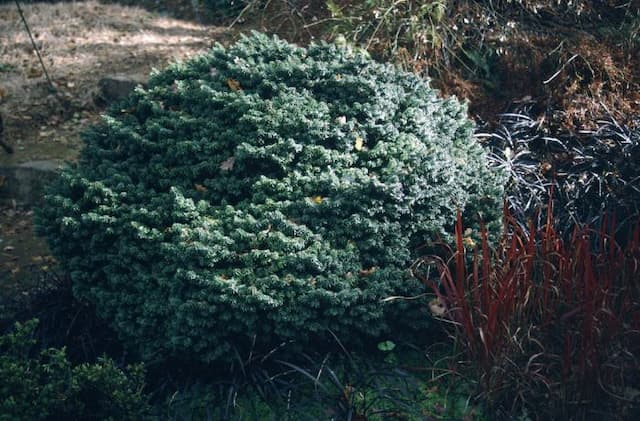Golden larch Pseudolarix amabilis

ABOUT
The plant commonly known as the golden larch is a visually striking species, notable for its distinctive conical shape reminiscent of a classic Christmas tree. Its branches are horizontally spread, creating a tiered appearance that is both symmetrical and aesthetically pleasing. The foliage consists of bright green, needle-like leaves which are soft to the touch. These needles cluster in gentle tufts along the branches, giving the plant a fluffy and full-bodied texture. As the seasons change, the golden larch undergoes a remarkable transformation. In autumn, the green leaves turn into a splendid display of golden-yellow, earning its common name as they create a warm, glowing effect within the landscape. This colorful foliage eventually falls off as winter approaches, leaving the tree bare. The bark of the plant is another notable feature, with a rough texture that can be described as fissured or cracked. It has a grayish-brown hue, serving as a rugged counterpoint to the softness of the leaves. When the tree is young, its bark tends to be smoother, becoming more deeply furrowed with age. The golden larch produces cones that are small, not particularly showy, and they add a subtle textural contrast to the branches. These cones are initially green before maturing to a brown color and they can be found nestled among the needles, often in the upper portions of the tree where they are more visible.
About this plant
 Names
NamesFamily
Pinaceae
Synonyms
Golden Larch, Chinese Golden Larch, Amabilis False Larch
Common names
Abies kaempferi var. amabilis, Larix kaempferi var. amabilis, Pinus amabilis, Pseudolarix fortunei.
 Toxicity
ToxicityTo humans
Golden larch (Pseudolarix amabilis) is not widely known to be toxic to humans. Most sources do not report it as a plant that causes poisoning upon ingestion. Therefore, there are no well-documented symptoms of poisoning by the golden larch in humans. As with any plant, individual allergic reactions or sensitivities could occur, but these are not typical or well-documented for this species.
To pets
The golden larch is also not widely known to be toxic to pets. It is not listed among the common plants that cause poisoning in pets like dogs and cats. Hence, there are no specific details on symptoms of poisoning by the golden larch in pets. General advice would be to prevent pets from ingesting plants when their toxicity status is uncertain, and to contact a veterinarian if any unusual symptoms occur after ingestion.
 Characteristics
CharacteristicsLife cycle
Perennials
Foliage type
Deciduous
Color of leaves
Green
Height
30 feet (9 meters)
Spread
20 feet (6 meters)
Plant type
Tree
Hardiness zones
4
Native area
China
Benefits
 General Benefits
General Benefits- Ornamental Value: Pseudolarix amabilis, commonly known as the golden larch, adds aesthetic appeal to landscapes with its bright yellow foliage in autumn.
- Shade Provider: Its large canopy can create shaded areas, improving comfort in gardens and parks during sunny days.
- Habitat for Wildlife: The tree can serve as a habitat and provide food for various wildlife species, including birds and insects.
- Erosion Control: The root system of golden larch can help stabilize soil and reduce erosion on slopes or in areas prone to land degradation.
- Seasonal Interest: Its distinctive seasonal changes, from green in spring and summer to golden in the fall, provide year-round interest in gardens and public spaces.
- Wood Production: While not its primary use, the wood of golden larch can be utilized for construction purposes, furniture, or craftwork given its durability.
- Cultural Significance: The species may hold cultural and traditional importance in certain regions, contributing to heritage landscapes and conservation efforts.
- Education and Research: As a unique species, it can be used in educational settings to teach about coniferous trees and botanical studies.
 Medical Properties
Medical Properties- Antifungal: Pseudolarix amabilis has been shown to contain compounds that exhibit antifungal activity.
- Anti-inflammatory: Extracts of the plant have been used to reduce inflammation in traditional medicine systems.
- Antitumor: Some studies suggest the presence of substances in Pseudolarix amabilis that might have potential antitumor effects.
- Antimicrobial: The plant has been associated with antimicrobial properties, which could inhibit the growth of certain bacteria and fungi.
- Abortifacient: Traditionally, it has been used to induce abortion, although such use is not supported by modern medical practice and can be risky.
 Air-purifying Qualities
Air-purifying QualitiesThis plant is not specifically known for air purifying qualities.
 Other Uses
Other Uses- Planting for Ornamental Value: The golden larch is often used for ornamental purposes due to its beautiful golden-yellow fall color and its unique conical shape, adding aesthetic value to parks and gardens.
- Use in Bonsai: Golden larch can be trained into bonsai form, appreciated for its fine needle-like foliage and ability to adapt to the compact and contorted shapes typical of bonsai art.
- Historical Use in Rituals: Some indigenous cultures may have used parts of the golden larch in ceremonial or ritualistic practices, utilizing the tree's symbolic association with certain virtues or seasonal transitions.
- Woodworking Material: The wood of the golden larch is sometimes used in woodworking for creating small crafts or decorative objects, although it's not commonly used for furniture due its limited availability.
- Subject for Photography and Painting: The striking appearance of the golden larch, especially in autumn, makes it a favored subject for photographers and painters who capture the essence of changing seasons.
- Educational Use: Golden larch can be used in educational settings such as arboretums or botanical gardens to teach dendrology, the study of trees, because of its unique deciduous conifer characteristics.
- Privacy Screens: In landscaping, tall and dense plantings of golden larch can create effective privacy screens while offering a soft, textured appearance.
- Urban Forestry: The tree can be incorporated into urban forestry projects, contributing to the diversity of urban tree species and improving cityscapes.
- Nature-Inspired Design: The golden larch's distinct form and color can inspire artists and designers in creating patterns and shapes for textiles, wallpaper, and other decorative elements.
- Animal Habitat: When planted in a suitable environment, the golden larch can provide natural habitat and food for various bird species and other wildlife.
Interesting Facts
 Feng Shui
Feng ShuiThe Golden Larch is not used in Feng Shui practice.
 Zodiac Sign Compitability
Zodiac Sign CompitabilityThe Golden Larch is not used in astrology practice.
 Plant Symbolism
Plant Symbolism- Endurance and Longevity: The golden larch is known for its hardiness and ability to withstand harsh conditions, making it a symbol of endurance and the ability to thrive over long periods.
- Beauty and Elegance: With its striking golden-yellow autumn foliage, the golden larch is associated with beauty and is often admired for its aesthetic charm, symbolizing grace and elegance.
- Change and Transformation: As a deciduous conifer that changes color with the seasons, the golden larch embodies the idea of transformation and the natural cycle of life, death, and rebirth.
- Rarity and Unique Nature: The golden larch is not as common as other trees, which can make it a symbol of rarity and exceptional characteristics, celebrating the uniqueness of an individual or situation.
 Water
WaterThe Golden Larch requires consistent moisture, especially during its growing season in the spring and summer. Water the plant deeply once a week, providing approximately 1 to 1.5 gallons of water each time, depending on the size of the tree and the weather conditions. During the hot summer months, you may need to water twice a week if there is insufficient rainfall. Reduce watering in the fall to prepare the tree for dormancy, and in winter, only water if the soil is very dry and the tree is not frozen, using a lesser amount of about half a gallon every couple of weeks.
 Light
LightGolden Larch thrives in full sunlight but can tolerate light shade. The best spot for this plant is an area where it will receive at least 6 hours of direct sunlight each day. Avoid deep shaded areas, as insufficient light can hamper the tree's growth and cause it to become leggy.
 Temperature
TemperatureThe Golden Larch can survive winter temperatures down to about -20 degrees Fahrenheit but prefers the temperature range of 50 to 70 degrees Fahrenheit. The ideal growing conditions for Golden Larch are cool to moderate climates where the temperatures don't typically exceed 75 degrees Fahrenheit during the summer months.
 Pruning
PruningPrune the Golden Larch to maintain its shape and health, removing any dead or diseased branches. The best time for pruning is late winter or early spring before new growth starts. Pruning once a year or every other year is typically sufficient, depending on the tree's growth rate and desired shape.
 Cleaning
CleaningAs needed
 Soil
SoilThe best soil mix for the Golden Larch (Pseudolarix amabilis) should be well-draining and slightly acidic to neutral, with a pH range of 5.0 to 7.5. A mixture incorporating peat, sand, and loamy garden soil can support healthy growth. Adding organic matter like compost can also enrich the soil.
 Repotting
RepottingGolden Larch should be repotted every two to three years, or when it becomes root-bound. Younger trees grow faster and may need more frequent repotting; attention to root health during the process is essential.
 Humidity & Misting
Humidity & MistingGolden Larch thrives in moderate to high humidity levels. While it can adapt to lower humidity, maintaining a range of 40-60% is ideal for optimal growth and health of the plant.
 Suitable locations
Suitable locationsIndoor
Provide bright light, moderate water, and well-draining soil for indoor Golden Larch.
Outdoor
Plant in well-draining soil with full sun to partial shade for outdoor Golden Larch.
Hardiness zone
4-7 USDA
 Life cycle
Life cycleThe Chinese Golden Larch (Pseudolarix amabilis) begins its life cycle when seeds are dispersed from mature cones, typically falling close to the parent tree. The seeds require a period of stratification - cold treatment - to break dormancy and germinate in the spring. The seedlings emerge and grow into young saplings, establishing a root system and, over several years, develop into juvenile trees. Throughout its life, the Chinese Golden Larch experiences seasonal changes, with bright green foliage in the spring turning to a vivid golden yellow before shedding its needles in the fall, as it is a deciduous conifer. With adequate sunlight, moisture, and soil conditions, the tree matures over many years, reaching up to 40 meters tall, and begins the reproductive phase, producing male and female cones. The cycle continues when mature cones release their seeds, completing the reproductive process.
 Propogation
PropogationPropogation time
Spring-Early Summer
The golden larch, or Pseudolarix amabilis, is most commonly propagated through seeds. For successful seed propagation, the best time is typically in the late winter or early spring, which coincides with the natural seed drop from mature trees. The seeds of the golden larch require a period of cold stratification to break dormancy; this is a process where seeds are exposed to cold, moist conditions for about 60 days (about 2 months). After this cold period, seeds can be sown in well-draining soil and lightly covered. The soil should be kept consistently moist but not waterlogged, and the seeds should germinate when temperatures rise in the spring. This method replicates the natural conditions seeds would experience outside, where they overwinter in the cold before sprouting with the onset of warm weather.









